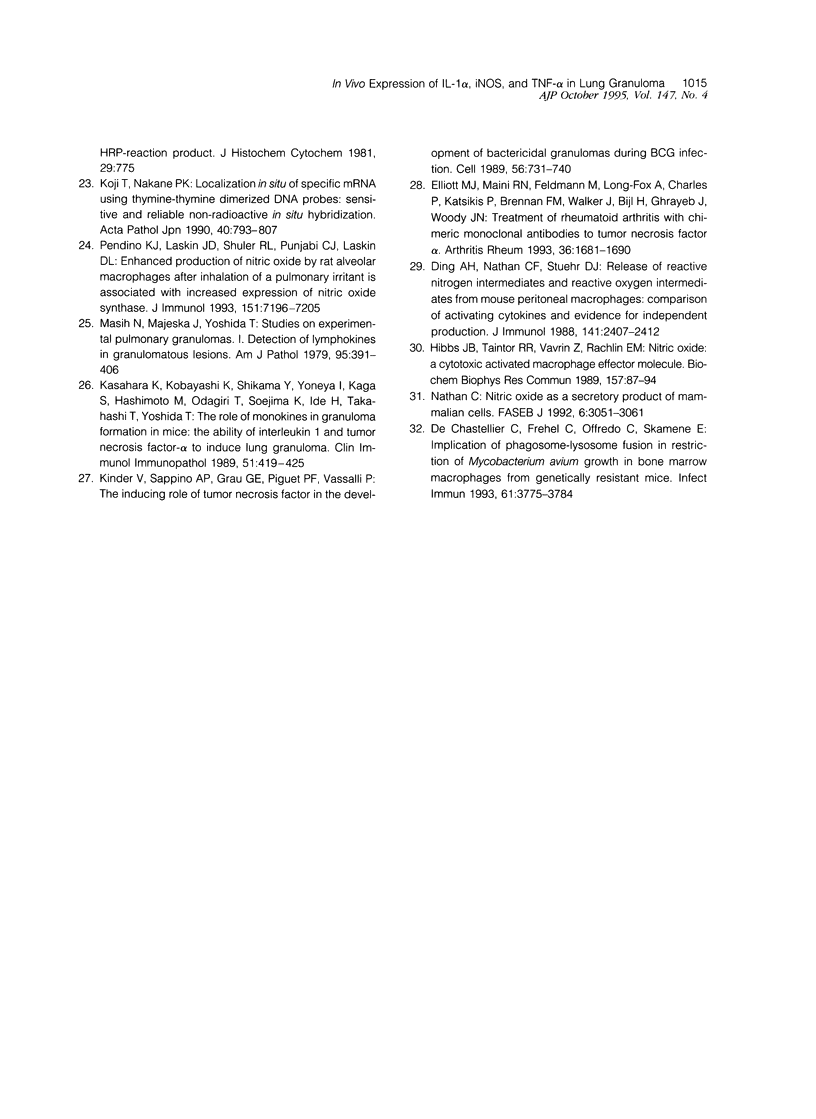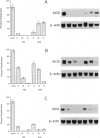Abstract
The present study examined the temporal pattern and localization of interleukin-1, tumor necrosis factor-alpha, and inducible nitric oxide synthase expression in lung tissue undergoing foreign body granuloma formation. Pulmonary granulomas were induced by the intratracheal injection of dextran beads into genetically high granuloma responder, carrying Bcgs (BALB/c), and low responder, carrying Bcgr (C3H/HeJ and DBA/2), mice. There was a pattern of sequential expression of these molecules in BALB/c mice. Thus, interleukin-1 alpha and inducible nitric oxide synthase were induced mostly in the cells accumulated around the beads and also in some bronchiolar epithelial cells during the early phase (1 to 3 days), whereas tumor necrosis factor-alpha was induced in the cells around the beads at the later resolution phase (3 to 7 days). By contrast, in low responder mice, an increase in the expression of interleukin-1 alpha and inducible nitric oxide synthase was detected in lung macrophages as well as in alveolar cells and bronchiolar epithelial cells on day 1, but that of tumor necrosis factor-alpha was not detected throughout the period. These results together with our previous findings on cytokine activity in granuloma extract suggest that interleukin-1 and nitric oxide produced by recruited macrophages may take part in the early, macrophage-dependent phase of granuloma formation whereas tumor necrosis factor-alpha may be more crucial as a mediator responsible for the difference in innate resistance or susceptibility to granuloma formation.
Full text
PDF














Images in this article
Selected References
These references are in PubMed. This may not be the complete list of references from this article.
- Adams D. O. The granulomatous inflammatory response. A review. Am J Pathol. 1976 Jul;84(1):164–192. [PMC free article] [PubMed] [Google Scholar]
- Allred D. C., Kobayashi K., Yoshida T. Anergy-like immunosuppression in mice bearing pulmonary foreign-body granulomatous inflammation. Am J Pathol. 1985 Dec;121(3):466–473. [PMC free article] [PubMed] [Google Scholar]
- Blackwell J. M., Roach T. I., Atkinson S. E., Ajioka J. W., Barton C. H., Shaw M. A. Genetic regulation of macrophage priming/activation: the Lsh gene story. Immunol Lett. 1991 Oct;30(2):241–248. doi: 10.1016/0165-2478(91)90032-6. [DOI] [PubMed] [Google Scholar]
- Boros D. L. Granulomatous inflammations. Prog Allergy. 1978;24:183–267. doi: 10.1159/000401230. [DOI] [PubMed] [Google Scholar]
- Buschman E., Taniyama T., Nakamura R., Skamene E. Functional expression of the Bcg gene in macrophages. Res Immunol. 1989 Oct;140(8):793–797. doi: 10.1016/0923-2494(89)90035-7. [DOI] [PubMed] [Google Scholar]
- Chensue S. W., Otterness I. G., Higashi G. I., Forsch C. S., Kunkel S. L. Monokine production by hypersensitivity (Schistosoma mansoni egg) and foreign body (Sephadex bead)-type granuloma macrophages. Evidence for sequential production of IL-1 and tumor necrosis factor. J Immunol. 1989 Feb 15;142(4):1281–1286. [PubMed] [Google Scholar]
- Chomczynski P., Sacchi N. Single-step method of RNA isolation by acid guanidinium thiocyanate-phenol-chloroform extraction. Anal Biochem. 1987 Apr;162(1):156–159. doi: 10.1006/abio.1987.9999. [DOI] [PubMed] [Google Scholar]
- Ding A. H., Nathan C. F., Stuehr D. J. Release of reactive nitrogen intermediates and reactive oxygen intermediates from mouse peritoneal macrophages. Comparison of activating cytokines and evidence for independent production. J Immunol. 1988 Oct 1;141(7):2407–2412. [PubMed] [Google Scholar]
- Elliott M. J., Maini R. N., Feldmann M., Long-Fox A., Charles P., Katsikis P., Brennan F. M., Walker J., Bijl H., Ghrayeb J. Treatment of rheumatoid arthritis with chimeric monoclonal antibodies to tumor necrosis factor alpha. Arthritis Rheum. 1993 Dec;36(12):1681–1690. doi: 10.1002/art.1780361206. [DOI] [PubMed] [Google Scholar]
- Forget A., Skamene E., Gros P., Miailhe A. C., Turcotte R. Differences in response among inbred mouse strains to infection with small doses of Mycobacterium bovis BCG. Infect Immun. 1981 Apr;32(1):42–47. doi: 10.1128/iai.32.1.42-47.1981. [DOI] [PMC free article] [PubMed] [Google Scholar]
- Goto Y., Buschman E., Skamene E. Regulation of host resistance to Mycobacterium intracellulare in vivo and in vitro by the Bcg gene. Immunogenetics. 1989;30(3):218–221. doi: 10.1007/BF02421210. [DOI] [PubMed] [Google Scholar]
- Hibbs J. B., Jr, Taintor R. R., Vavrin Z., Rachlin E. M. Nitric oxide: a cytotoxic activated macrophage effector molecule. Biochem Biophys Res Commun. 1988 Nov 30;157(1):87–94. doi: 10.1016/s0006-291x(88)80015-9. [DOI] [PubMed] [Google Scholar]
- Joseph A. L., Boros D. L. Tumor necrosis factor plays a role in Schistosoma mansoni egg-induced granulomatous inflammation. J Immunol. 1993 Nov 15;151(10):5461–5471. [PubMed] [Google Scholar]
- Kasahara K., Kobayashi K., Shikama Y., Yoneya I., Kaga S., Hashimoto M., Odagiri T., Soejima K., Ide H., Takahashi T. The role of monokines in granuloma formation in mice: the ability of interleukin 1 and tumor necrosis factor-alpha to induce lung granulomas. Clin Immunol Immunopathol. 1989 Jun;51(3):419–425. doi: 10.1016/0090-1229(89)90040-8. [DOI] [PubMed] [Google Scholar]
- Kasahara K., Kobayashi K., Shikama Y., Yoneya I., Soezima K., Ide H., Takahashi T. Direct evidence for granuloma-inducing activity of interleukin-1. Induction of experimental pulmonary granuloma formation in mice by interleukin-1-coupled beads. Am J Pathol. 1988 Mar;130(3):629–638. [PMC free article] [PubMed] [Google Scholar]
- Kindler V., Sappino A. P., Grau G. E., Piguet P. F., Vassalli P. The inducing role of tumor necrosis factor in the development of bactericidal granulomas during BCG infection. Cell. 1989 Mar 10;56(5):731–740. doi: 10.1016/0092-8674(89)90676-4. [DOI] [PubMed] [Google Scholar]
- Kobayashi K., Allred C., Castriotta R., Yoshida T. Strain variation of bacillus Calmette-Guerin-induced pulmonary granuloma formation is correlated with anergy and the local production of migration inhibition factor and interleukin 1. Am J Pathol. 1985 May;119(2):223–235. [PMC free article] [PubMed] [Google Scholar]
- Kobayashi K., Allred C., Cohen S., Yoshida T. Role of interleukin 1 in experimental pulmonary granuloma in mice. J Immunol. 1985 Jan;134(1):358–364. [PubMed] [Google Scholar]
- Koji T., Brenner R. M. Localization of estrogen receptor messenger ribonucleic acid in rhesus monkey uterus by nonradioactive in situ hybridization with digoxigenin-labeled oligodeoxynucleotides. Endocrinology. 1993 Jan;132(1):382–392. doi: 10.1210/endo.132.1.8419136. [DOI] [PubMed] [Google Scholar]
- Koji T., Chedid M., Rubin J. S., Slayden O. D., Csaky K. G., Aaronson S. A., Brenner R. M. Progesterone-dependent expression of keratinocyte growth factor mRNA in stromal cells of the primate endometrium: keratinocyte growth factor as a progestomedin. J Cell Biol. 1994 Apr;125(2):393–401. doi: 10.1083/jcb.125.2.393. [DOI] [PMC free article] [PubMed] [Google Scholar]
- Koji T., Nakane P. K. Localization in situ of specific mRNA using thymine-thymine dimerized DNA probes. Sensitive and reliable non-radioactive in situ hybridization. Acta Pathol Jpn. 1990 Nov;40(11):793–807. doi: 10.1111/j.1440-1827.1990.tb02492.x. [DOI] [PubMed] [Google Scholar]
- Kunkel S. L., Chensue S. W., Strieter R. M., Lynch J. P., Remick D. G. Cellular and molecular aspects of granulomatous inflammation. Am J Respir Cell Mol Biol. 1989 Dec;1(6):439–447. doi: 10.1165/ajrcmb/1.6.439. [DOI] [PubMed] [Google Scholar]
- Lowenstein C. J., Glatt C. S., Bredt D. S., Snyder S. H. Cloned and expressed macrophage nitric oxide synthase contrasts with the brain enzyme. Proc Natl Acad Sci U S A. 1992 Aug 1;89(15):6711–6715. doi: 10.1073/pnas.89.15.6711. [DOI] [PMC free article] [PubMed] [Google Scholar]
- Masih N., Majeska J., Yoshida T. Studies on experimental pulmonary granulomas. I. Detection of lymphokines in granulomatous lesions. Am J Pathol. 1979 May;95(2):391–406. [PMC free article] [PubMed] [Google Scholar]
- Nathan C. Nitric oxide as a secretory product of mammalian cells. FASEB J. 1992 Sep;6(12):3051–3064. [PubMed] [Google Scholar]
- Pendino K. J., Laskin J. D., Shuler R. L., Punjabi C. J., Laskin D. L. Enhanced production of nitric oxide by rat alveolar macrophages after inhalation of a pulmonary irritant is associated with increased expression of nitric oxide synthase. J Immunol. 1993 Dec 15;151(12):7196–7205. [PubMed] [Google Scholar]
- Sato I. Y., Kobayashi K., Kasama T., Kaga S., Kasahara K., Kanemitsu H., Nakatani K., Takahashi T., Nakamura R. M., Skamene E. Regulation of Mycobacterium bovis BCG and foreign body granulomas in mice by the Bcg gene. Infect Immun. 1990 May;58(5):1210–1216. doi: 10.1128/iai.58.5.1210-1216.1990. [DOI] [PMC free article] [PubMed] [Google Scholar]
- Shikama Y., Kobayashi K., Kasahara K., Kaga S., Hashimoto M., Yoneya I., Hosoda S., Soejima K., Ide H., Takahashi T. Granuloma formation by artificial microparticles in vitro. Macrophages and monokines play a critical role in granuloma formation. Am J Pathol. 1989 Jun;134(6):1189–1199. [PMC free article] [PubMed] [Google Scholar]
- Skamene E., Gros P., Forget A., Patel P. J., Nesbitt M. N. Regulation of resistance to leprosy by chromosome 1 locus in the mouse. Immunogenetics. 1984;19(2):117–124. doi: 10.1007/BF00387854. [DOI] [PubMed] [Google Scholar]
- Skamene E., Pietrangeli C. E. Genetics of the immune response to infectious pathogens. Curr Opin Immunol. 1991 Aug;3(4):511–517. doi: 10.1016/0952-7915(91)90013-q. [DOI] [PubMed] [Google Scholar]
- de Chastellier C., Fréhel C., Offredo C., Skamene E. Implication of phagosome-lysosome fusion in restriction of Mycobacterium avium growth in bone marrow macrophages from genetically resistant mice. Infect Immun. 1993 Sep;61(9):3775–3784. doi: 10.1128/iai.61.9.3775-3784.1993. [DOI] [PMC free article] [PubMed] [Google Scholar]












